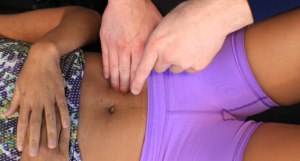Palpate the psoas and confirm the palpation with this simple test. A new article uses an evidence-based approach to bust a recent manual therapy myth!
— Dr. Brent Brookbush, CEO of Brookbush Institute
NEW YORK, NEW YORK, UNITED STATES, November 16, 2023 /EINPresswire.com/ — Snippet from the Article:
– You Can Palpate the Psoas
And the related course:
– Static Manual Release: Hip Flexors
Including the video:
– Static Manual Release (and Palpation): Psoas and Iliacus
The idea that the psoas cannot be palpated is a relatively recent assertion, and it seems to be part of a “Nihilistic” or “contrarian” movement in the physical rehabilitation professions (PTs, PTAs, ATCs, DCs, LMTs, OTs, etc.). These Nihilists seem dedicated to proving that nothing we do is effective, and the answer to the question, “Can you palpate the psoas?” has become a sort of “stress test” to determine whether or not someone is part of the contrarian movement. However, similar to the flat-Earth conspiracy, the theory has been tested scientifically, and the test results have demonstrated that the contrarians are wrong. It is both possible and easy to test the accuracy of psoas palpation, and there are several randomized controlled trials (RCTs) demonstrating that dry needling and manual release of the psoas are effective modalities for treating several dysfunctions.
Quick Summary of the Facts:
– Individuals claiming that the psoas cannot be palpated, are using the “definition swap game” to alter the definition of “palpation” into a version that is easily attacked. This debate tactic is a variation of the logical fallacy known as a “straw man argument”.
– Based on the conventional use of the word palpation by health and medical professionals (e.g. “perceptible by the touch”), the psoas can be palpated.
– There is an easy and effective method for testing the accuracy of psoas palpation (hip flexion) during manual release techniques.
– Although the reliability of psoas palpation has not been specifically investigated in a peer-reviewed and published study, several studies (including several RCTs) have demonstrated the efficacy of psoas release techniques. This implies these techniques have at least some reliability, as a lack of reliability would result in inconsistent technique performance and inconsistent improvement in outcomes. Inconsistent improvements are likely to lead to insufficient average improvements to result in statistically significant outcomes in comparative studies.
Instructions for Manual Release of the Psoas
Intent: Apply pressure to the psoas with the intent of using “ischemic compression” to release trigger points and areas of increased tissue density or sensitivity. This technique may be indicated if a restriction is noted during lumbar rotation, hip extension, or hip internal rotation.
Palpation and Differentiation
1. The psoas is a deep muscle, lying behind the abdominal muscles and viscera. With the patient in supine, ask them to adjust their clothing to reveal their abdominal region. With a little practice, this technique may be performed through thin clothing; however, for patient comfort, it may be better to move clothing and reduce the amount of friction between the skin, clothing, and the practitioner’s fingers. Ask the patient to assume a “hook-lying” position with a slight posterior pelvic tilt to reduce tension in the abdominal wall muscles.
2. Identify the anterior superior iliac spine (ASIS) and semilunar line (lateral border of the rectus abdominis). Place one hand over the other so that the extended fingers and distal interphalangeal joints (IPJs) are braced with the extended fingers of the other hand.
3. Place the fingertips on the semilunar lines below the level of the umbilicus.
4. Depress your fingers into the abdomen toward the lumbar spine. Author’s note: The psoas originates on the lumbar spine and inserts into the lesser trochanter; the belly of the muscle is likely deep and/or medial to the semilunar lines. Often this technique is depicted as if the psoas were very lateral, abutting the external obliques. They do not. Although the notion of “working around” the abdominal viscera is appreciated, doing this technique inaccurately likely poses a larger risk than responsibly pressing into the viscera with as little additional “searching” or “pressure” as possible.
6. To aid in reducing the discomfort of depressing into the abdominal contents and stretching skin, continue to adjust the skin on the fingertips to reduce tension, and try to press deeper during the client/patient’s exhalations. Following the belly down during breathing makes this technique more comfortable.
7. Look for a vertically oriented, tube-like structure that is a bit more dense than other soft tissues in the area.
Clinical Gems
Test the accuracy of psoas palpation by asking the patient to flex their hip (lift their foot off the table) after it is believed the psoas has been located. Hip flexion will cause the psoas to contact and feel as though it became denser, moved, or “jumped” into the fingers. Internal organs do not contract and generally do not move with hip flexion. If it is suspected that the contraction is the rectus abdominis, have the patient/client perform a crunch and then perform hip flexion. Although hip flexion may cause the rectus abdominis to contract to stabilize the pelvis, once a rectus abdominis contraction is felt and confirmed, differentiating between the superficial rectus abdominis and the deep psoas is not difficult. Additionally, the patient may be cued to perform hip flexion and lumbar extension (“lift their leg” while “arching their back”) in an attempt to reciprocally inhibit the rectus abdominis while cuing a psoas contraction. Note, do not assume that any dense structure, or tube-shaped structure, is the psoas. Several structures may feel dense or tube-shaped when compressed, and some of these structures may be more vulnerable to tissue damage with careless compression or abrasion. The only abdominal structures that will contract with hip flexion are the psoas and iliacus (the iliacus is located on the internal face of the ilium). Check the accuracy of palpation every time the technique is performed. It is better to be slower and more accurate.
Check out the rest of the article, pre-approved courses, and embedded video by following the links at the top of this post.
Brent Brookbush
Brookbush Institute
+1 201-206-9665
email us here
Visit us on social media:
Facebook
Twitter
LinkedIn
Instagram
YouTube
TikTok
Static Manual Release: Psoas and Iliacus
![]()
Originally published at https://www.einpresswire.com/article/668592768/how-to-palpate-the-psoas




